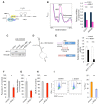The Translational Machinery of Human CD4+ T Cells Is Poised for Activation and Controls the Switch from Quiescence to Metabolic Remodeling
- PMID: 30197303
- PMCID: PMC6773601
- DOI: 10.1016/j.cmet.2018.08.009
The Translational Machinery of Human CD4+ T Cells Is Poised for Activation and Controls the Switch from Quiescence to Metabolic Remodeling
Erratum in
-
The Translational Machinery of Human CD4+ T Cells Is Poised for Activation and Controls the Switch from Quiescence to Metabolic Remodeling.Cell Metab. 2018 Dec 4;28(6):961. doi: 10.1016/j.cmet.2018.09.010. Cell Metab. 2018. PMID: 30517897 Free PMC article. No abstract available.
Abstract
Naive T cells respond to T cell receptor (TCR) activation by leaving quiescence, remodeling metabolism, initiating expansion, and differentiating toward effector T cells. The molecular mechanisms coordinating the naive to effector transition are central to the functioning of the immune system, but remain elusive. Here, we discover that T cells fulfill this transitional process through translational control. Naive cells accumulate untranslated mRNAs encoding for glycolysis and fatty acid synthesis factors and possess a translational machinery poised for immediate protein synthesis. Upon TCR engagement, activation of the translational machinery leads to synthesis of GLUT1 protein to drive glucose entry. Subsequently, translation of ACC1 mRNA completes metabolic reprogramming toward an effector phenotype. Notably, inhibition of the eIF4F complex abrogates lymphocyte metabolic activation and differentiation, suggesting ACC1 to be a key regulatory node. Thus, our results demonstrate that translation is a direct mediator of T cell metabolism and indicate translation factors as targets for novel immunotherapeutic approaches.
Keywords: ACC1; CD4(+) T cell; GLUT1; eIF4E; eIF6; metabolism; metabolome; proteome; transcriptome; translational control.
Copyright © 2018 Elsevier Inc. All rights reserved.
Figures






Comment in
-
T cells under starter's orders.Nat Rev Immunol. 2018 Oct;18(10):600-601. doi: 10.1038/s41577-018-0067-6. Nat Rev Immunol. 2018. PMID: 30206315 No abstract available.
-
Peeking under the Hood of Naive T Cells.Cell Metab. 2018 Dec 4;28(6):801-802. doi: 10.1016/j.cmet.2018.11.008. Cell Metab. 2018. PMID: 30517891 Free PMC article.
References
-
- Alain T, Morita M, Fonseca BD, Yanagiya A, Siddiqui N, Bhat M, Zammit D, Marcus V, Metrakos P, Voyer LA, et al. eIF4E/4E-BP ratio predicts the efficacy of mTOR targeted therapies. Cancer Res. 2012;72:6468–6476. - PubMed
-
- Berod L, Friedrich C, Nandan A, Freitag J, Hagemann S, Harmrolfs K, Sandouk A, Hesse C, Castro CN, Bahre H, et al. De novo fatty acid synthesis controls the fate between regulatory T and T helper 17 cells. Nat Med. 2014;20:1327–1333. - PubMed
Publication types
MeSH terms
Substances
Grants and funding
LinkOut - more resources
Full Text Sources
Other Literature Sources
Research Materials
Miscellaneous

